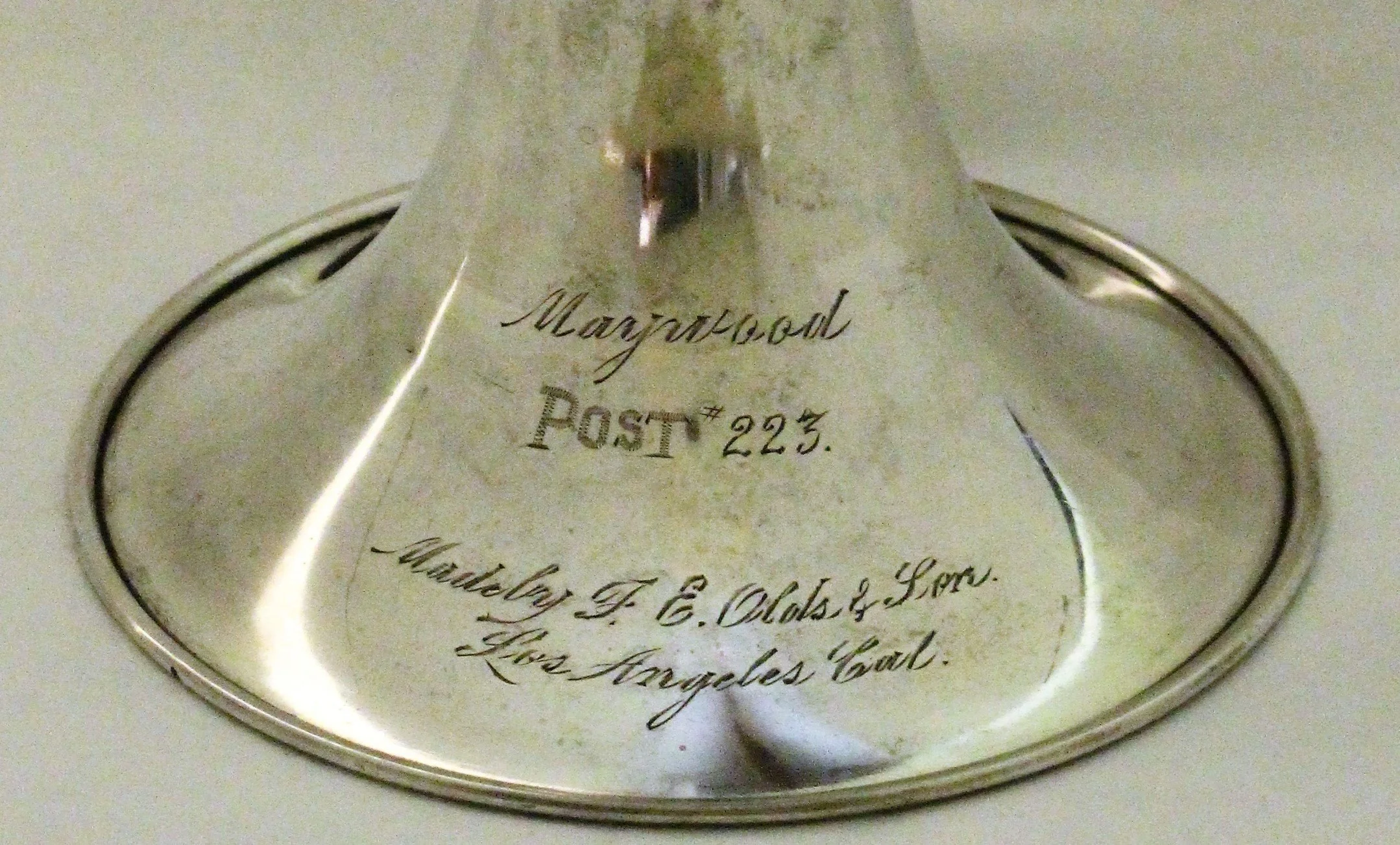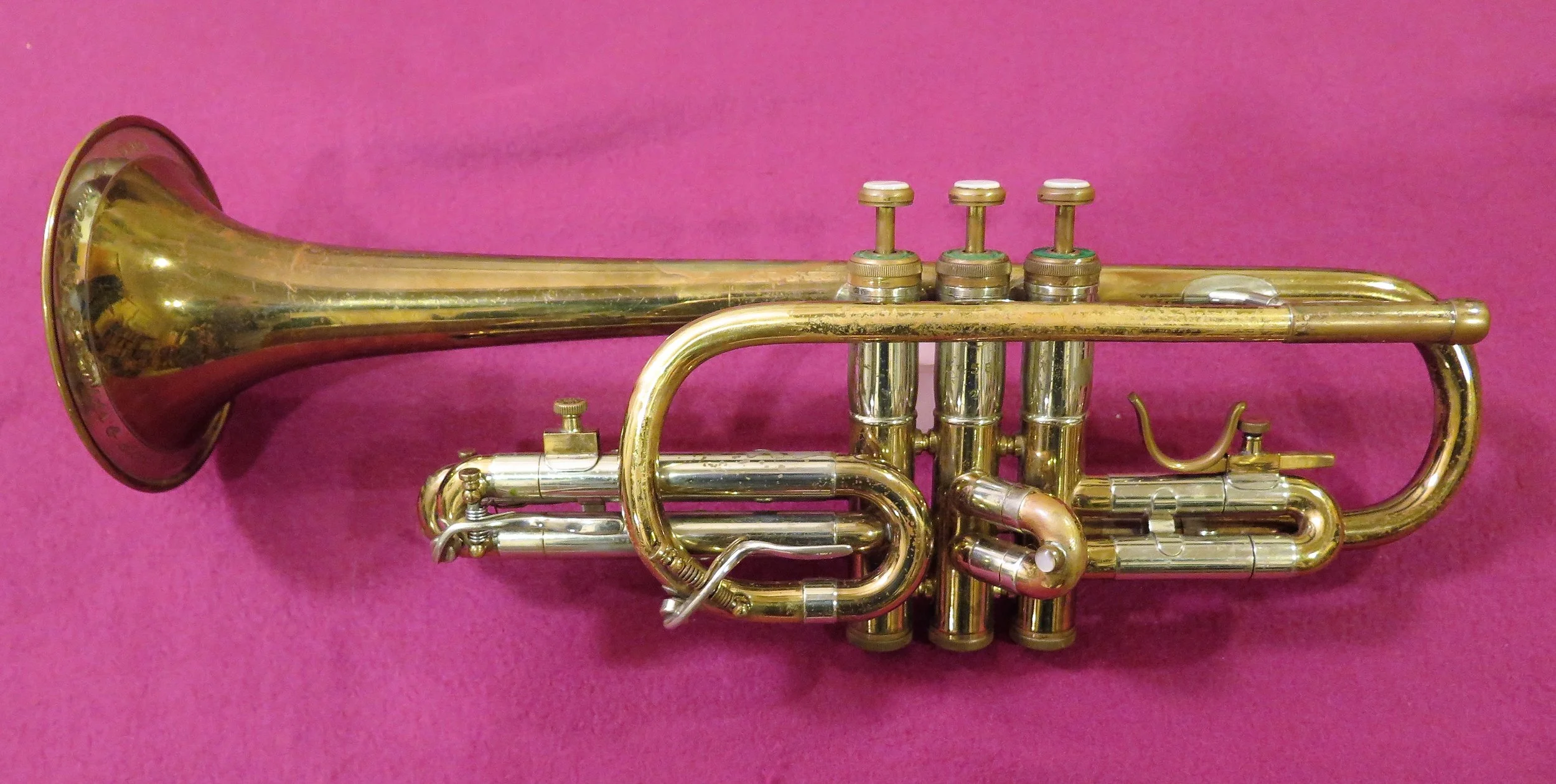Unique Instruments Made by F.E. Olds & Son
I feature below some unique instruments made by F.E. Olds & Son. I hope that you enjoy this diversion from an all-too-serious real world.
At the time of his death, Sid Lazar owned less than 20 instruments and about 40 mouthpieces, not a large number in my experience. His daughter told me that he never got rid of anything, but I recall working on an early Bach C trumpet for him in the early 1980s that was not among them. Most of his instruments were typical of his era, working in Los Angeles: Besson, Benge, Bach and Olds.
Engraving on the four unique instruments that had belonged to Sid Lazar.
Very mysteriously, he also owned a set of four instruments, each engraved “Property of F.E. Olds & Son Fullerton Calif.” The engraving is in the style used on Mendez models from 1952 through the 1970s and also used on the Custom Crafted line. These include three “natural” or fanfare trumpets in Bb (one octave below a Bb trumpet). Each has a large throated bell and 5 1/4” rim diameter. One of the three is loosely assembled from six parts, held together with short slide tubes and clamping screws and there are five extra tubes that fit the clamped sockets.
Three Olds natural trumpets in Bb and the extra attachments.
I couldn’t make sense of the shorter alternate tubes until I realized that six of the seven were the same length. I was able to replace the 180 degree curves with either the straight sections, making a straight nine foot, or the 90 degree “Ls” to make a zig-zag shape. All three configurations play in Bb.
In addition, the intermediate straight tube can be assembled with the bell and tuning mouthpipe, making 4 1/2” trumpet or “coach horn” in Bb (last photo above).
The fourth instrument is a tenor trombone with small bell rim, presumably to imitate the look of an early trombone or sackbutt.
Olds ‘sachbutt”, Bb tenor trombone.
Presumably, these were used by Olds for educational “kiddie concerts” (school assemblies) to help the children understand some of the very basic physics of brass instruments, with the goal of sparking interest in them. Including a modern Bb trumpet with valves and a modern trombone and a couple of simple musical arrangements could make this quite effective.
In their 1960s and 1970s catalogs, Olds listed Post Horns available in Bb with alternate slide for C, but never with a photo. Most Olds fans have never seen one, but one is pictured below that was never finished at the factory.
Olds also made bugles, not just the famous bugle corps family with valves that they made in the 1970. Two U.S. Regulation bugles are known, one pictured below made for the American Legion and another, belonging to R. Dale Olson with hammered finish bell (not pictured). The last is in Bb, photo provided by owner, John Thorne. It utilizes Olds Special model parts without the valves.
The next “mystery horn” is not signed by Olds, but made entirely of Olds parts. It is a slide trumpet with tuning in the slide using the same mechanism as all early Olds trombones. It came from the estate of Dick Charles, who owned a music store in Glendale, California for many years. This is the sort of thing that repairmen will build out of used parts horns, but the build quality is quite good and I suspect that it was built by an Olds employee, perhaps at the factory, using obsolete parts from stock. Notice the offset in the bell tail, allowing more clearance for the chin while playing.
Olds Slide trumpet.
Another from Dick Charles’ collection is an Olds Bb trumpet made in the mid-1930s. Several features differ from other Olds models at the time: the fixed slide hook on the first slide, the forward sloping second valve slide as in most Besson trumpets and most interestingly, the second valve is offset to the left, like in later Recording models. I have seen only one other Olds trumpet like this one as it was being restored by Zig Kanstul. These mush have been custom made, trying out new ideas. This and the slide trumpet were sold to Arnold Ruskin, who left his excellent collection of Olds instruments to the National Music Museum upon his death.
A left handed cornet from the collection of Tom Meacham of Anchorage, Alaska, is not just a rearrangement of standard parts, but rather a mirror image design. This necessitates machining mirror image parts for the valve casings and pistons, drilling the holes in exact opposite positions of the standard, mass produces parts. Tom took a photo of it next to a standard Olds Super model cornet for emphasis, both made about 1950. There are at least two examples known of mirror image Olds Super trumpets as well.
Next are a couple of Olds trumpets with rotary valves. The first appears to have been made at Olds using German valve assemblies in the early 1930s. Notice that the curves of the bell and tuning crook are wider than a standard Olds trumpet and carefully made for this design. I know nothing more of this other than it was in the possession of Howard Wilson at the time of his death. Howard had worked for Olds starting in 1950. The second of these was given to me by Bernie Marsten, who had made all the rotary valves for Olds from the late 1950s until about 1964, when Olds resumed making their rotary valves in house. Bernie made this trumpet using Olds bell, mouthpipe and tuning assembly, rotary valves and lever mechanism that he made himself. He never quite finished it, but it is quite playable as it is.
To celebrate our country’s bicentennial, Olds made just a few Special model trumpets with very special engraving as seen below.
Another from Tom Meacham’s collection is a cornet with two bells. The most surprising feature is that the forward facing bell, is not connected to the air column. When playing, the sound is directed at the player’s neck. Also, both first and third valves are whole steps, making it even more confusing to play. This is made mostly of Ambassador cornet parts and has a serial number 000000. Both bells are engraved: “F.E. Olds & Son / Manufactured for Howard / 1977”. We don’t know for sure who Howard was, but we believe that it was Howard Wilson, who worked for Olds from about 1950. Howard’s widow remembers that he had made a unique instrument during the filming of a TV show, “Success Story” at their request, but didn’t finish it. Dale Olson suggests that perhaps Don Agard, the general manager at the time may have had the instrument finished in order to present it to Howard. It seems likely that this was given to Howard at a retirement party. It was restored for Tom by Mark Metzler.
Another Olds instrument with two bells is only known for this photo of it in the hands of Julius “Billy” Brooks. Judging by his youthful looks, I would guess that it was taken in the early 1950s. The trumpet appears to be an Olds Standard from before WWII or immediately after. In 1969, Elizabeth Brooks, presumably Billy’s wife, registered a trademark for the term “Skoonum Horn”. In the same year, Billy applied for a patent which was granted a year later. In the patent text, he claims that the trumpet “is able to generate like notes from the lower and upper bells of similar volume but different in pitch and brilliance. The notes generated by the trumpet are clear and in tune throughout the entire range of the trumpet…”. The trumpet that Brooks famously played for several decades after that was made by Dominic Calicchio. It is now in the Hartenberger World Music Collections, which states that it was made in 1973 or 1974. That trumpet was there-after known as his Skoonum Horn and he was listed in the Musician’s Union, Local 47 as the only player of this instrument. The Calicchio shop log books, which are very chaotic, indicate the Brooks had at least eight trumpets made by Dominic Calicchio between 1969 and 1980, but none of the entries mention unusual features. I suspect that Mr. Brooks had Dominic Calicchio modify one or more of these trumpets at a later date and the brass secondary bell lends to that theory. In the Calicchio instrument, the secondary bell was smaller in flare, diameter and length, but still, somehow was designed so that the sound exited both bells. I don’t understand the acoustics and have never been able to examine this instrument, but others who have played it assure me that the sound does exit both bells. In the Olds example, the bells appear to be the same size and length. I can only guess that the earlier instrument was either custom made for Brooks by Olds or modified by another shop and eventually he began calling it his “Skoonum Horn”. If anybody has more information on this instrument or knows of its whereabouts, please let me know.
Billy Brooks with Olds two bell trumpet, about 1950.
There certainly are other one of a kind and otherwise unusual instrument made by Olds, such as the Recording trumpets made for Uan Rasey and Manny Stevens and probably many more that I haven’t heard about. If you have a unique instrument made by Olds, please let me know and I’ll add it to this page if you like.

























